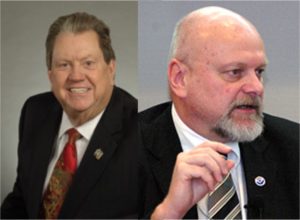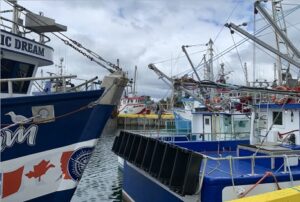Longstanding fisheries act doesn’t need changing says Hogarth and Murawski, Sam Parisi disagrees
 Those who catch ocean fish, dine on the country’s marine bounty or simply appreciate the remarkable improvement in the state of America’s fisheries can thank the Magnuson-Stevens Fishery Conservation and Management Act. From its passage in 1976, the nation’s premier fisheries law has been remarkably free of the party politics so often exhibited these days. And that’s exactly why we need to be careful about some current initiatives to change it. As we approach the transition to a new administration, however, a number of proposals have emerged to revise the law or change its administrative guidelines. Unfortunately, these would loosen effective protections that have been so successful in eliminating overfishing and rebuilding stocks. Read the rest here Fishermen take another hit. NOAA wins again. How can you beat them? It seems like the deck is stacked against fishermen. Take the case in New Hampshire (”Judge rules for government in monitoring suit,” July 29). The judge ruled under the law he does not have to take into account any other scientific data. In other words, what NOAA research vessels say is the bottom line. First of all, ask a real fishermen with 20 or more years experience if those on the NOAA research vessel know what they are doing. They will tell you perhaps not. If the judge was ruling because of the way the law is written, then we need to change the law .It has been more than 50 years since the Magnuson-Stevens Act was passed. A lot has changed. We need to review the act and if necessary modify it, or our fishermen will never be able to beat NOAA in a court of law. Sam Parisi Gloucester 14:20
Those who catch ocean fish, dine on the country’s marine bounty or simply appreciate the remarkable improvement in the state of America’s fisheries can thank the Magnuson-Stevens Fishery Conservation and Management Act. From its passage in 1976, the nation’s premier fisheries law has been remarkably free of the party politics so often exhibited these days. And that’s exactly why we need to be careful about some current initiatives to change it. As we approach the transition to a new administration, however, a number of proposals have emerged to revise the law or change its administrative guidelines. Unfortunately, these would loosen effective protections that have been so successful in eliminating overfishing and rebuilding stocks. Read the rest here Fishermen take another hit. NOAA wins again. How can you beat them? It seems like the deck is stacked against fishermen. Take the case in New Hampshire (”Judge rules for government in monitoring suit,” July 29). The judge ruled under the law he does not have to take into account any other scientific data. In other words, what NOAA research vessels say is the bottom line. First of all, ask a real fishermen with 20 or more years experience if those on the NOAA research vessel know what they are doing. They will tell you perhaps not. If the judge was ruling because of the way the law is written, then we need to change the law .It has been more than 50 years since the Magnuson-Stevens Act was passed. A lot has changed. We need to review the act and if necessary modify it, or our fishermen will never be able to beat NOAA in a court of law. Sam Parisi Gloucester 14:20


















































“Much of our recent success has stemmed from quick action and firm timetables for rebuilding, and that approach has clearly worked.” (from above article)
Well No, that’s not quite true… Allowable Catch Quotas are still shrinking each year for most fisheries in spite of NOAA declarations of eliminating “overfishing” because the stock population recovery is not living up to unrealistic timelines perhaps? And more than half of the local family fishing operations have been eliminated. Fishing ports along with shoreside support businesses are disappearing. So what exactly is the authors’ idea of having clearly worked?
I guess it depends on the goal of all this management.
East Coast fishing communities have been devastated by the legislated rigidity in the timelines for rebuilding historically varying fish populations. Even Jane Lubchenco, NOAA Fisheries Director admitted in a congressional hearing that there was no scientific basis for the rigid rebuilding timelines in the 2006 Reauthorization of Magnuson Act. She was a contributor to the infamous “Oceans of Abundance” treatise http://www.edf.org/sites/default/files/oceans-of-abundance.pdf This was an eco-political leaflet and primer sponsored by and filled with NGO lobbyist talking points aimed at the signers of the 2006 reauthorization that installed the rigid timelines.
The proposals for flexibility, transparency, predictability, fishermen representation, and taking into account the environmental and socio-economic aspects of fishery management in this current reauthorization bill before Congress are long overdue.And actually most of these current reauthorization proposals are simply reinforcing and making more specific several existing—but mostly ignored by management—MSA Standards relating to “setting catch limits based on science” and insuring that it’s the “best available science” through utilizing cooperative surveys and assessments from “other sources” (National Standard 2). Current proposals also reinforce the National Standards 1, 4, and 8, which account for the survival of the fishing communities along with the fish.
Flexibility and transparency as stated in the House Proposals does not mean the elimination or undermining the necessity of catch limits based on science and flexibility in rebuilding timelines is not “…a slippery slope back to unsustainable fisheries.”
Flexibility in dealing with naturally varying fish growth and recovery rates is intelligent management practice. The current House Bill proposals clearly do not reverse or “gut” any of the basic fish replenishing tenets of the Magnuson Stevens Act:
Please see original proposals from the House Natural Resources website: http://naturalresources.house.gov/newsroom/documentsingle.aspx?DocumentID=364840
None of the proposals are an attempt to”…loosen effective protections that have been so successful in eliminating overfishing and rebuilding stocks”.
All the proposed changes are suggesting is to include the fishing communities in the process and some common scientific sense regarding rebuilding expectations . After all this is “Fisheries” management, not “Fish” management, right?
For additional reading on the MSA proposed improvements please papers by Meghan Lapp and Dr. Brian J. Rothschild
http://centerforsustainablefisheries.org/wp-content/uploads/MSA-and-Its-Ten-Year-Timeline.M.Lapp_.pdf
http://centerforsustainablefisheries.org/wp-content/uploads/IMPROVING-THE-MAGNUSON-STEVENS-ACT.-B.Rothschild-Testimony.pdf
Do you really want to know what drives this bus? At the end of the day we are nothing more than pawns in this sickening game of globalization. And there’s only one person that I see willing to stand up to it. Donald Trump. Why do you think the powers that be from all around the globe fear him. In my opinion they fear him because he will blow the lid off of their sick game that everyone is failing to see and grasp.
Time for a dose of reality….Read on
http://www.globalresearch.ca/the-true-story-of-the-bilderberg-group-and-what-they-may-be-planning-now/13808
http://americanpolicy.org/agenda21/
Current fisheries regulation is clearly a, ‘Death by a thousand cuts,” approach to eliminating fishermen from the coastal waters of the US. The monuments and sanctuaries, the mandate to continuously reduce bycatch (So that no matter how clean you fish it will never be good enough), the quota reductions based on non-government organization platitudes and media hype (Let’s rename them forage fish and get further reductions), and the pile on of additional government organizations like OSHA and EPA (Making it illegal to discharge anything from a vessel but engine cooling water and then only after the heat polution has been removed.)
It’s all designed very well to destroy what remains of a once vibrant business that families and private citizens owned a big part of and turn it into a Wal-mart style business that can be bought or sold by the highest bidder.
Thanks to Dicky G for the most excellent and informative comment above the links provided offered a ckear explanation of the new re-authorization (Which I support.)